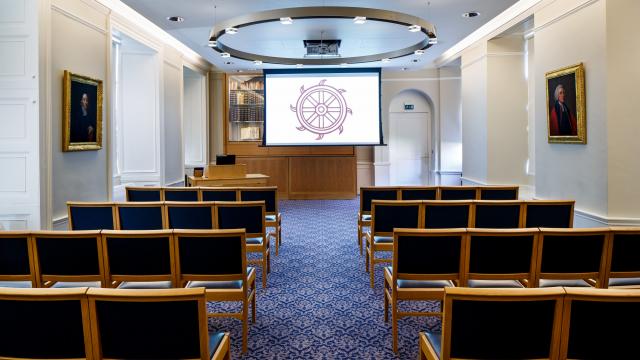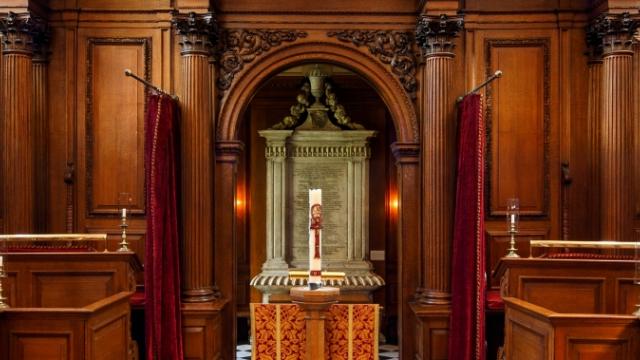
A plantation bell that was on display at St Catharine’s until 2019 will help to reveal global stories and histories of exploitation, resilience and liberation as part of the Fitzwilliam Museum’s major exhibition, Black Atlantic: Power, People, Resistance (8 September 2023–7 January 2024).
The bell will be among the historical pieces exhibited in dialogue with works by modern and contemporary Black artists, including Donald Locke, Barbara Walker, Keith Piper, Alberta Whittle and Jacqueline Bishop.
Luke Syson, Director and Marlay Curator of the Fitzwilliam Museum, said:
“Black Atlantic: Power, People, Resistance is an important moment in the history of the Fitzwilliam. Reflecting on the origins of our museum, the exhibition situates us within an enormous transatlantic story of exploitation and enslavement, one whose legacy is in many ways as pervasive and insidious today as it was in the 17th, 18th or 19th century. Our exhibition is greatly indebted to the contemporary artists whose work is featured. They have looked to the past to imagine a different future. By showing their works with significant historical objects, from Cambridge and leading institutions across Britain and elsewhere in Europe, we are rethinking our shared histories to help us consider the ways we can contribute to a better, repaired world, in which principles of equity are enshrined.”
The Lead Curator of Black Atlantic: Power, People, Resistance is Dr Jake Subryan Richards, Assistant Professor of International History at the London School of Economics and Political Science, and his co-curator is Dr Victoria Avery, Keeper of European Sculpture & Decorative Arts at the Fitzwilliam Museum.
About the bell
After consultation across the College community, the Master, Fellows and students of St Catharine’s decided to move the bell from its prominent position at the entrance to the College. This decision in May 2019 was reached after detailed research confirmed that the bell, which is inscribed ‘DE CATHARINA 1772’, was found in the Demerara River, Guyana, adjacent to the historical location of the De Catharina slave plantation.
One use of such bells on plantations was to control the work cycles of enslaved men, women, and children. The bell was presented to the College by a former student in 1960 and was installed at the entrance way soon after. Apart from its recovery and presentation by a former student, there is no other historical connection between the College and the bell.
In 2020, St Catharine’s initiated negotiations about returning the bell to Guyana, subject to the agreement of the Guyanese High Commissioner and the National Museum at Georgetown. While these conversations have been progressing, the College has received loan requests from leading museums seeking to present the bell in its complete historical context. In 2021, the bell was displayed by the Rijksmuseum, the Dutch national museum for art and history in Amsterdam, during its groundbreaking exhibition on slavery.
Professor Sir Mark Welland (2016), Master of St Catharine’s, commented:
“Since 2019, the bell has supported a more honest approach to the legacies of enslavement, within our own community at St Catharine’s and in wider society. The Fitzwilliam Museum’s choice to present historical objects like the bell alongside works by modern and contemporary Black artists encourages us to confront the injustice that was perpetuated by the UK and other countries over many centuries, and consider what these legacies mean for our present and future. I want to thank the College’s Works of Art Committee, and in particular Dr Colin Higgins (2018) as Custodian of the Works of Art, for enabling the bell to be displayed by the Fitzwilliam Museum in this way.”
In the exhibition catalogue, Dr Avery’s comments on the bell’s history include:
“While its sound may have been welcome to the plantation’s owners and overseers, and to prospective produce buyers, it would have been traumatic and triggering to the enslaved workforce, signifying nothing but brutal labour, violence and oppression. The traumatic ringing of the bell likely continued under British rule after the Napoleonic Wars.
“At an unrecorded point, this bell ended up in the River Demerara adjacent to the plantation, presumably violently toppled during the Demerara uprising of 1823, or after the abolition of slavery in the British Caribbean in the 1830s. In 1958 or 1959, it was spotted, semi-submerged in the river, by Edward Arthur Goodland, an alumnus of St Catharine’s College, Cambridge (graduated 1933), who working in Guyana as a Technical Director of Bookers Sugar Estates… Goodland decided to present the bell to his old college, and had it transported from Georgetown to Cambridge in 1960.”







